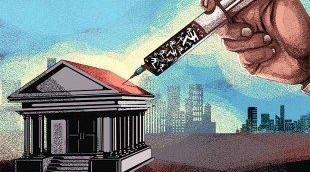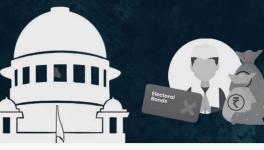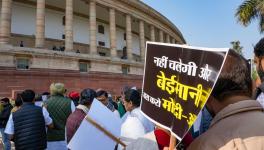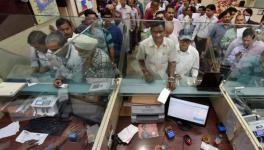Bank Recapitalisation or Three Ring Circus?

Today, yet another bright idea of government regarding the manner of bank recapitalisation has been fed to the media. Since the announcement 15 days ago of its plan of recapitalisation of the Public-Sector Banks (PSBs) with Rs. 2.11 lakh crores, the government sources have been letting us know of the myriad schemes through which this recapitalisation will be done. Initially there was a proposal of creating Special Purpose Vehicle (SPV) to recapitalise banks – so that the recapitalisation can stay off the budget books. And, there was the idea of other public sector companies financing the recapitalisation bonds. Then, there was an even more outlandish scheme of asking the banks to buy their own recapitalisation bonds, using their customer’s deposits. Before all these, was the suggestion made in government’s Economic Survey, 2016-17, to recapitalising the PSBs by redeploying RBI’s own capital. To top them all, there was the suggestion to recapitalise the banks with the Rs. 3.5 lakh crore black money uncovered through demonetisation, which nobody talks about today.
The new idea seems to be that government would ask the RBI to use some of its ample foreign exchange reserves of over $ 400 billion, to provide some or all the Rs. 2.11 lakh crore of the announced bank capital.
RBI has set aside these forex reserves mainly to absorb shocks of any adverse events of capital flow out of India. Thisis to avoid a crisis where India may not have enough forex reserves to maintain a reasonable exchange rate or meet its external obligations, in which case it would be forced to go begging to other countries or institutions like IMF. The examples of the previous financial crises in East Asia and Latin America have shown that this is a path Indiashould rather avoid. Of course, India can put in place a set of regulations for to strictly control the inflow and outflow of capital, but that is a discussion for another day.
These are the foreign exchange reserves; the government seems to be eying right now to fund bank recapitalisation. If we go by the new idea, RBI would invest Rs. 2.11 lakh crore or $ 32 billion worth forex reserves in the banks, thereby capitalising them. To that extent, RBI will assume the ownership of the PSBs.
To keep this $ 32 billion, from having an impact on the exchange rate, RBI may have to buy back foreign exchange of same amount form the market or even the banks themselves, thereby putting Rs. 2.11 lakh crore rupees in to circulation. The effective summary of this move is that RBI simply printed and gave Indian currency to banks in exchange of the public-sector bank shares.
On the other hand, if RBI thinks Rs. 2.11 lakh crores of additional liquidity in the system is not good, and it needs to be mopped up – then it may use the Market Stabilisation Scheme (MSS) to sterilise the liquidity.
During demonetisation, RBI used MSS to absorb the excess deposits of the banking sector. Under this scheme, government issued specific securities to RBI, which in its turn passed them on to the banks, in exchange of the new deposits. This put interest paying government securities in the hands of the banks and broughtcurrency deposits back to the RBI. These deposits effectively belonged to the government which issued the securities in the first place. But under the MSS, money was not to be used by the government for its budgetary activities. It simply stayed put in its account with the RBI. These securities issues under MSS were not considered as part of the fiscal deficit.
Similarly, using MSS to mop up of Rs. 2.11 lakh crores from the system, would mean thatin effect government had recapitalised the banks through debt. But had taken this debt off its books, through a complex accounting trick.
The question that comes up - Why is the government tying itself in to these complicated knots, over something as simple as recapitalisation? All it had to do is allocate Rs. 2.11 lakh out of its budget for the bank’s capital. It can fund this amount by issuing securities to the RBI, in a straightforward transaction.
Even more pertinent question - why is the government giving so much time and publicity to the problem of recapitalisation, which is not really problem? Why is it forcing the capital adequacy norms on the banks, thereby creating an artificial capital shortage for the PSBs?
The so-called Basel norms for bank capital adequacy, according to which the Indian PSBs fall short of capital, have not severed any purpose since their institution in 1988. There was Basel I in 1988, followed by Basel II in 2004 and now there is Basel III – like a particularly bad movie franchise. So far none of these norms have prevented the many banking crises all over the world, that have been happening over the years, biggest among all being the 2008 crisis.
After all, before the onset of neoliberal era in the 1990s, Indian public sector banks were discharging their functions with low levels of capital. They have not experienced any banks runs or closures. Thetheoretical argument for sufficient bank capital is that it provides the element of trust to the customers, which is necessary for banks to run and avoid panics of depositors. Yet, the fact that public sector banks are owned by the government allows for very high levels of trust, irrespective of the size of their capital.
One can only conclude that all the fuss the government is making over the recapitalisation, is meant to divert the attention away from what the government is not really doing? - which is tackling India’s big capital, the corporates that have become fat on the banks loans, which they now refuse to pay back.
The three-ring circus around recapitalisation, reminds one of a similar one around demonetisation. Within two years of the BJP government’s tenure, the Swiss leaks and Panama paper leaks exposed the problem of black money in the hands of Indian corporates and the tax havens that help them hide it. To divert the public attention away from the problem black money in tax havens and the subsequent label of Suit -Boot Sarkar, the government embarked on demonetisation. Itcreated a bogey man out of cash, instead of the tacking the real problem black money flowing out of India.
Now,the government is doing the same with the problem of NPAs and bank recapitalisation. Mr. Jaitely is cunningly shifting the public discourse away from the money that Indian Big Capital has stolen from the banks, to the non-issue of bank recapitalisation.
Instead of hearing on what the finance ministry is doing to bring to book the corporate criminals – what we hear about every day is the umpteen meaningless ways the government can recapitalise banks without showing on its books.
Get the latest reports & analysis with people's perspective on Protests, movements & deep analytical videos, discussions of the current affairs in your Telegram app. Subscribe to NewsClick's Telegram channel & get Real-Time updates on stories, as they get published on our website.
























